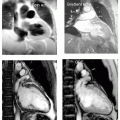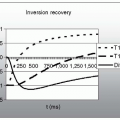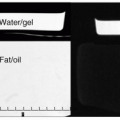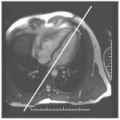Cardiac Tagging
Mark Doyle
Because there are very few fixed reference points in the heart, detection of relative motion is inherently difficult to assess. Cardiac tagging provides a gridded reference frame from which to assess relative motion throughout the cardiac cycle for all regions of the myocardium. Initially, the grid is imposed on the heart at the start of the cardiac cycle and deforms with the myocardium throughout the cycle.
PRINCIPLE OF TAGGING
Tags can be applied by the spatial amplitude modulation method (SPAMM) technique.
The essence of the SPAMM approach is to sinusoidally vary the signal across the image plane (see Fig. 28-1). When viewed as an image, this directly translates to an alternating dark-light stripe pattern across the entire image. To achieve this sinusoidal pattern, it is not necessary to vary the amplitude of the signal, only its phase (see Fig. 28-2). Tags are implemented by the following two operations:
Inverting the spin system
Varying the phase of the inversion signal cyclically
Application of a gradient across the body imposes a progressive accumulation of phase angle for all excited spins. In SPAMM tagging, a gradient is applied which imposes the required sinusoidal variation in phase across the image plane. In the SPAMM sequence, spins are initially tipped over using a 90-degree radiofrequency (RF) pulse (see Fig. 28-3). Next, a gradient is applied to vary the phase of the spins in a sinusoidal manner. Following this, a second RF pulse is applied which rotates in phase spins back along the positive axis and further tips the out-of-phase spins toward full inversion.
SPATIAL AMPLITUDE MODULATION METHOD
The combination of a 90-degree RF-gradient-90-degree RF combination was the arrangement used in the original implementation of SPAMM. This combination of RF gradient-RF is referred to as a 1-1 pulse, because the amplitude of each RF pulse is the same (i.e., 1), which corresponds to 90 degrees in this case. The basic SPAMM sequence produces a series of stripes across the image plane. A grid can be simply produced by applying a second SPAMM sequence, with the gradient oriented in the orthogonal direction. The two sets of overlapping stripe patterns produce the tag grid (see Fig. 28-4).
GRID PROPERTIES
The gradient area determines the stripe spacing and width. Stripes persist longest when the spins are inverted. As the cardiac cycle advances, tag contrast diminishes because of recovery of the spin system toward equilibrium. The stripe or grid tags are typically applied at the start of the electrocardiogram (ECG) R wave. However, the placement of tags inserts a time delay between the R wave and the first image that can be acquired.
IMPROVED TAG DEFINITION
The basic 1-1 pulse only allows formation of sinusoidal tags, which means that the tag lines are not sharply defined. It transpires that the 1-1 pulse




Stay updated, free articles. Join our Telegram channel

Full access? Get Clinical Tree








